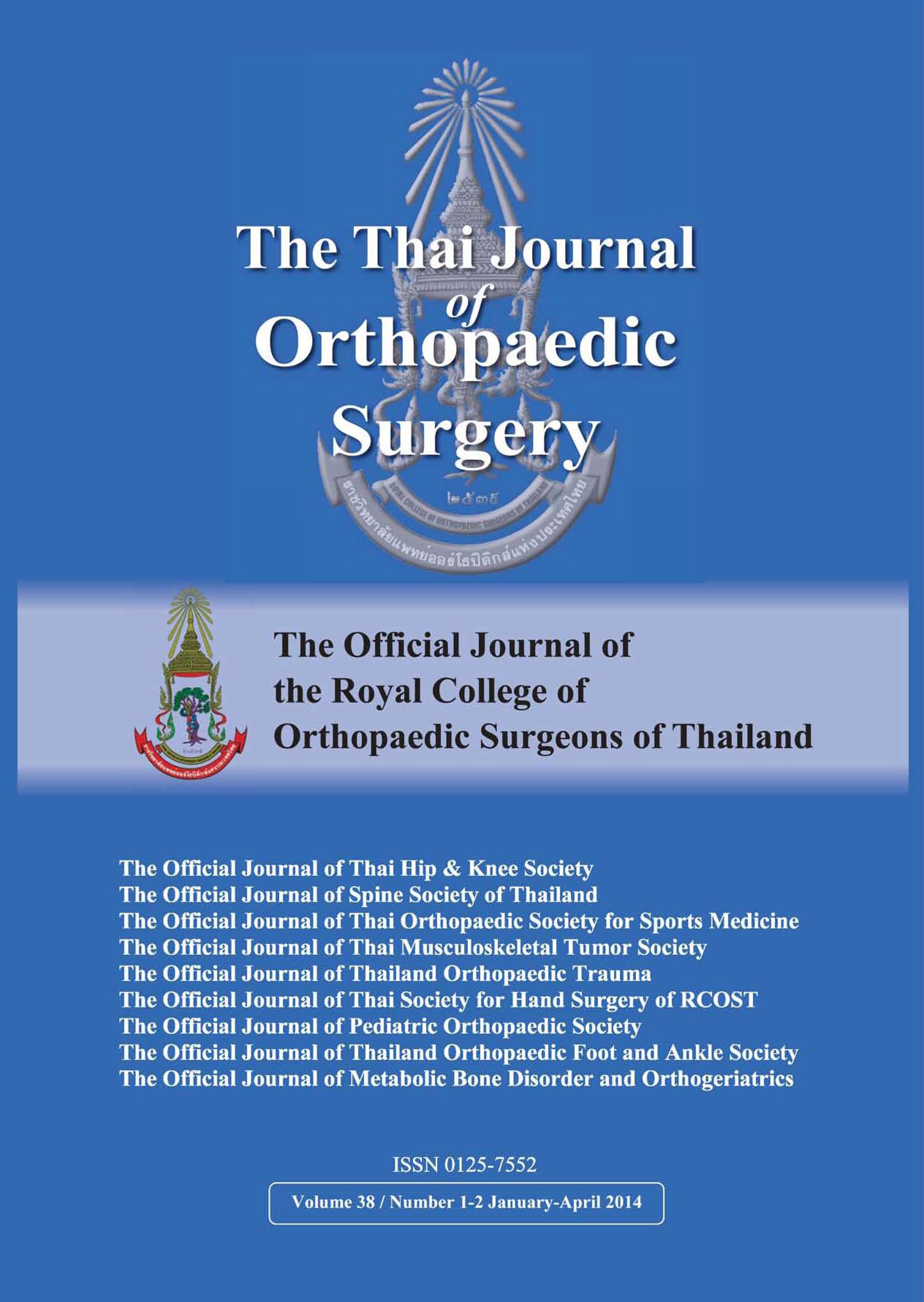Comparison between Percutaneous Needle Release and Local Corticosteroid Injection for the Treatment of Tennis Elbow
Main Article Content
Abstract
Purpose: The goal of treatment of tennis elbow is to treat tendinosis. Percutaneous needle release is one of the treatment options but does not have comparative outcomes with standard treatments. To compare the clinical outcomes between percutaneous needle release and local corticosteroid injection in tennis elbow disease.
Methods: A prospective randomized controlled study was conducted. Forty-nine tennis elbow patients were divided into two groups by randomization. Twenty-four patients were assigned to the corticosteroid injection group and 25 patients were assigned to the percutaneous needle release group. Both groups were assessed for visual analog scale (VAS), grip strength, and infection before treatment and 2 weeks, 1, 2, 3, and 6 months after the procedures.
Results: All demographic data, baseline VAS, and grip strength were not statistically different between groups. The difference of VAS compared to baseline at 2 weeks, 1, 2, 3, and 6 months were 5.86, 6.14, 5.57, 5.09, and 4.85 for the corticosteroid group and 2.68, 3.93, 4.74, 4.38, and 4.35 for the percutaneous needle release group, respectively. The difference of grip strength compared to baseline at 2 weeks, 1, 2, 3, and 6 months were 8.73, 10.42, 10.83, 9.55, and 8.55 for the corticosteroid group and 3.43, 4.65, 7.80, 6.88, and 7.06 for the percutaneous needle release group, respectively. The improvement of VAS and grip strength in the corticosteroid group was superior to the percutaneous needle release group, but there was statistical significance only at 2 weeks and 1 month follow ups (P = <0.001, <0.001, 0.001, 0.005, respectively). No case of infection was detected during the follow up period.
Conclusion: A corticosteroid injection improved pain and grip strength in tennis elbow disease more than percutaneous needle release, but was statistically significant only at 2 weeks and 1 month after treatments.
Article Details
References
2. Canale ST, Beaty JH. Campbell's Operative Orthopaedics, 11th ed. Philadelphia: Mosby Elsevier; 2008.
3. Altay T, Günal I, Oztürk H. Local injection treatment for lateral epicondylitis. Clin Orthop Relat Res 2002; 398: 127-30.
4. Dunkow PD, Jatti M, Muddu BN. A comparison of open and percutaneous techniques in the surgical treatment of tennis elbow. J Bone Joint Surg Br 2004; 86: 701-4.
5. Solheim E, Hegna J, Øyen J. Extensor tendon release in tennis elbow: results and prognostic factors in 80 elbows. Knee Surg Sports Traumatol Arthrosc 2011; 19: 1023-7.
6. Nirschl RP, Pettrone FA. Tennis elbow. The surgical treatment of lateral epicondylitis. J Bone Joint Surg Am 1979; 61: 832-9.
7. John M. McShane, MD, Vinil N. Shah, MD, Levon N. Nazarian, MD Sonographically Guided Percutaneous Needle Tenotomy for Treatment of Common Extensor Tendinosis in the Elbow J Ultrasound Med 2008; 27: 1137-4.
8. Jiaan Z, Bing H, Chunyan X, Jia L. Ultrasound-guided, minimally invasive, percutaneous needle puncture treatment for tennis elbow. Advances in Therapy. 2008; 25: 1031-6.
9. Kayastha N, Joshi A, Chand P, Thapa B, Rana S, Singh B, et al.Treatment Outcome of Tennis Elbow by Percutaneous Needle Tenotomy. MJSBH 2012; 11: 32-5.
10. Lakhey S, Mansfield M, Pradhan RL, Rijal KP, Paney BP, Manandhar RR. Percutaneous extensor tenotomy for chronic tennis elbow using an 18G needle. Kathmandu Univ Med J (KUMJ) 2007; 5: 446-8.
11. Grundberg AB, Dobson JF. Percutaneous release of the common extensor origin for tennis elbow. Clin Orthop 2000; 376: 137-40.
12. Malanga, GA and Nadler S. Musculoskeletal Physical Examination: an Evidence-based Approach. Philadelphia, PA: Elsevier Mosby, 2006.
13. Espandar R, Heidari P, Rasouli MR, Saadat S, Farzan M, Rostami M, et al. Use of anatomic measurement to guide injection of botulinum toxin for the management of chronic lateral epicondylitis: a randomised controlled trial. CMAJ 2010; 182: 749-50.


